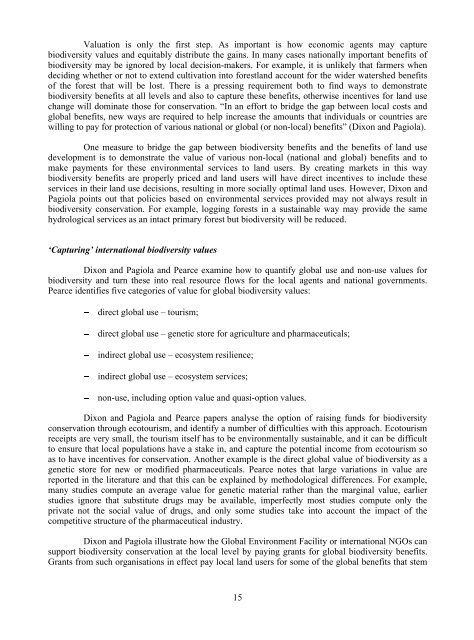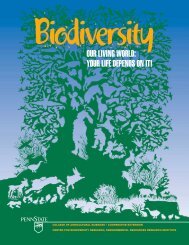Valuation of Biodiversity Benefits (OECD)
Valuation of Biodiversity Benefits (OECD)
Valuation of Biodiversity Benefits (OECD)
- No tags were found...
You also want an ePaper? Increase the reach of your titles
YUMPU automatically turns print PDFs into web optimized ePapers that Google loves.
<strong>Valuation</strong> is only the first step. As important is how economic agents may capturebiodiversity values and equitably distribute the gains. In many cases nationally important benefits <strong>of</strong>biodiversity may be ignored by local decision-makers. For example, it is unlikely that farmers whendeciding whether or not to extend cultivation into forestland account for the wider watershed benefits<strong>of</strong> the forest that will be lost. There is a pressing requirement both to find ways to demonstratebiodiversity benefits at all levels and also to capture these benefits, otherwise incentives for land usechange will dominate those for conservation. “In an effort to bridge the gap between local costs andglobal benefits, new ways are required to help increase the amounts that individuals or countries arewilling to pay for protection <strong>of</strong> various national or global (or non-local) benefits” (Dixon and Pagiola).One measure to bridge the gap between biodiversity benefits and the benefits <strong>of</strong> land usedevelopment is to demonstrate the value <strong>of</strong> various non-local (national and global) benefits and tomake payments for these environmental services to land users. By creating markets in this waybiodiversity benefits are properly priced and land users will have direct incentives to include theseservices in their land use decisions, resulting in more socially optimal land uses. However, Dixon andPagiola points out that policies based on environmental services provided may not always result inbiodiversity conservation. For example, logging forests in a sustainable way may provide the samehydrological services as an intact primary forest but biodiversity will be reduced.‘Capturing’ international biodiversity valuesDixon and Pagiola and Pearce examine how to quantify global use and non-use values forbiodiversity and turn these into real resource flows for the local agents and national governments.Pearce identifies five categories <strong>of</strong> value for global biodiversity values:- direct global use – tourism;- direct global use – genetic store for agriculture and pharmaceuticals;- indirect global use – ecosystem resilience;- indirect global use – ecosystem services;- non-use, including option value and quasi-option values.Dixon and Pagiola and Pearce papers analyse the option <strong>of</strong> raising funds for biodiversityconservation through ecotourism, and identify a number <strong>of</strong> difficulties with this approach. Ecotourismreceipts are very small, the tourism itself has to be environmentally sustainable, and it can be difficultto ensure that local populations have a stake in, and capture the potential income from ecotourism soas to have incentives for conservation. Another example is the direct global value <strong>of</strong> biodiversity as agenetic store for new or modified pharmaceuticals. Pearce notes that large variations in value arereported in the literature and that this can be explained by methodological differences. For example,many studies compute an average value for genetic material rather than the marginal value, earlierstudies ignore that substitute drugs may be available, imperfectly most studies compute only theprivate not the social value <strong>of</strong> drugs, and only some studies take into account the impact <strong>of</strong> thecompetitive structure <strong>of</strong> the pharmaceutical industry.Dixon and Pagiola illustrate how the Global Environment Facility or international NGOs cansupport biodiversity conservation at the local level by paying grants for global biodiversity benefits.Grants from such organisations in effect pay local land users for some <strong>of</strong> the global benefits that stem15












